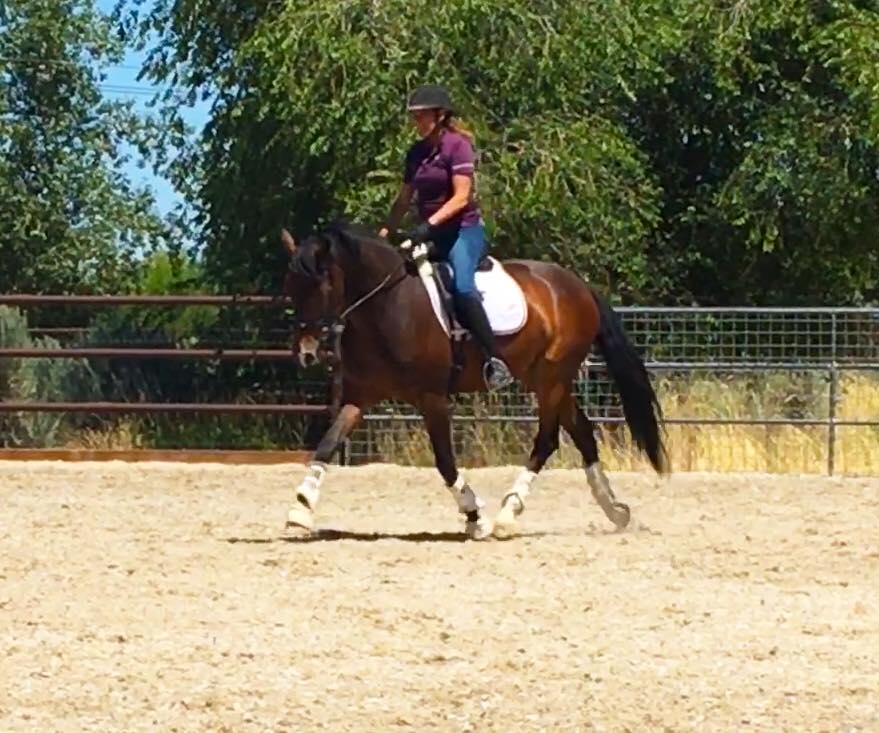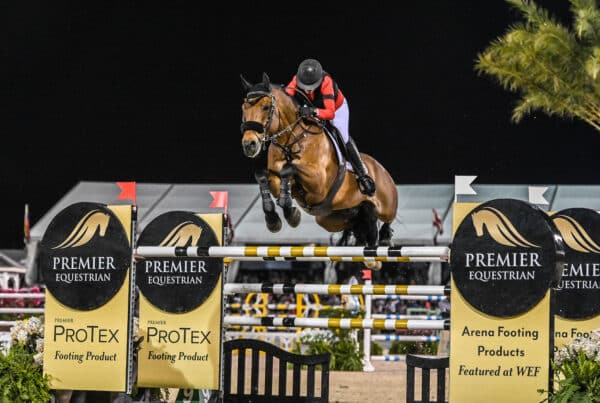By Heidi Zorn
One of the most popular questions I get is, “What is the importance of good footing?” In my opinion, there isn’t just one cut and dry answer. As equestrian hobbies and competitions evolve and progress, it is becoming increasingly more important for us to be aware of the surfaces we ride our beloved equine partners on. My own understanding of the importance of good footing was a very long, painful, and emotional journey that my beautiful gelding, Serrano, ultimately suffered through the most.
Serrano’s Story

There in the arena with Serrano, I told the breeder that I might have to pass, and at that moment Serrano looked at me shook his head as if to say, “No!” and then ran down the long side of the arena and jumped through the chute. He proceeded to do this five more times all by himself. We sat there in bewilderment, I had never seen a horse voluntarily run around and jump like that. I took this as a sign that he was choosing me and was determined that I see it his way. He was right, it has been the best decision I ever made. From that moment on my journey with Serrano proceeded to teach me about dressage, horsemanship and footing.
Serrano is a large horse 1600 lbs. and 17 hands with a heart of gold. Our troubles started when he was 10 years old and he began to show an unwillingness to go forward, mentally and physically. Eventually, it became apparent this struggle was manifesting because of pain in his hips and hocks. Thinking it was attributed to age, I began regular treatments with a chiropractor, but the results were short-lived.
Serrano started to show advanced signs of lameness, and after several different approaches I was fortunate enough to find a farrier who was able to better support his conformational downfalls. He inspired me to examine the horse’s anatomy and how biomechanics related to the surfaces we ride on.
I learned that the deep surfaces I had been riding him on only exacerbated his conformational challenges. Learning about the flight of the foot helped me identify how different surfaces altered Serrano’s gait. He felt the very best on a stable, grass surface. I became conscious of the surfaces we rode on, even taking steps to modify them to increase stability. Serrano continued training for a few more years, however all that wear and tear led to arthritis in his hocks. I decided to do a hock injection.
Unfortunately, that hock injection went septic and just about took his life. It destroyed the joint and caused me to retire him permanently. I was devastated. I had learned so much from Serrano over the years, and I felt like there was still more to do together. Many of us equestrians have had to suffer the loss of a remarkable partner, and we all tend to obsess about the things we could have done differently to avoid such catastrophe.
For me, I wished I’d started him as a four-year-old on the stable surface right off the bat. While there are many factors that play into the longevity of a horse’s career, I do believe it would have made a significant difference had I understood more about surfaces and how they affect our horses. Today Serrano is 24 years old and doing well in retirement.
What is the cost of a bad surface?
The cost of bad footing was a lot higher than I could have imagined. Not only was I out of a horse, I was also out of the money I had invested in him. Think for a moment about what you paid for your own horse. Now think of the costs to board and train him or her every month or every year. Then add on the cost of regular vet and maintenance, and then add some more for extra maintenance (specialized vet work, chiropractic, equine massage, supplements, customized tack, etc.). Now think of the amount it would take to put your horse into early retirement along with the costs associated with purchasing a new horse. That for me, was when I truly realized the cost of riding on a bad surface.

Once Serrano was retired, I found myself in the market for another horse because I so desperately wanted to continue riding. After a lot of time and effort I found Sting. He was an older FEI schoolmaster that could teach me more about the higher levels of dressage. After my experience with Serrano, it was important for me to ride Sting on a biomechanically superior surface. Armored with new knowledge on arena surfaces, I was able to keep him comfortable and in work.
Compared to Serrano, Sting required a little different surface qualities. Serrano was more comfortable on stable and compact surfaces that supported his large body. Sting needed rebound and cushioning to help support his soles and joints. When working in a higher degree of collection, adequate stability and grip helped him to perform his best. Riding Sting really helped me dial in what a proper riding surface should consist of. Sting was my partner for three years until I unfortunately lost him to colic in 2015.
Today, I have an amazing arena surface that is multipurpose for dressage, jumping, lounging and turnout. We designed it with OTTO Sport mats and a custom Premier blend of footing suited for these needs.
Currently, I have a lovely Westphalian gelding named Primo, and a Lusitano mare named Izzy. Primo is just starting his dressage career and having a quality surface to support his biomechanics gives both of us confidence. I am looking forward to developing his balance and relaxation as we continue his training. Izzy has been a very interesting a quirky mount that continues to keep my life interesting.

The cost of retiring Serrano at 16 yrs old

These experiences have driven me to become an expert in understanding everything that goes into creating high-quality footing to help other horses and owners avoid suffering the same fate, emotionally and financially. I will never again make the mistake of asking my horses to perform on substandard surfaces. I believe these amazing creatures deserve the best, and I love working with horse owners on finding the best way improve their arena surfaces. I will always be grateful to my Serrano for showing us the way forward.
ALL CONTENT COPYRIGHT 2020 PREMIER EQUESTRIAN














